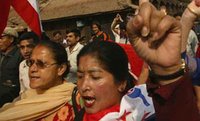The Royal Nepal Army
 The Royal Nepal Army: Meeting the Maoist Challenge
The Royal Nepal Army: Meeting the Maoist ChallengeBy Ashok K. Mehta
Rupa & Co
Pages 110
Price Rs 295
The Gurkhas constitute about half a dozen battalions of the Indian Army, and a couple in the British Army. They are among the world’s best soldiers. Yet, why aren’t their brothers in the Royal Nepal Army winning the war against the Maoists in their home country, Nepal?
Ashok Mehta, a retired major-general from the Indian Army, himself an ex-Gurkha officer, offers the answer right in the beginning of this book. "The ceremonial nature of the RNA, lack of combat experience, absence of a regimental system, excessive preoccupation with UNPKO [United Nations Peace-Keeping Operations], lack of intelligence, the assumption that the RNA should have a policing as well as a fighting role and the feudal nature of Nepal’s ruling classes have prevented the RNA from developing into a representative and national fighting force capable of taking on the Maoist challenge."
Mehta goes on to explain: "The Maoists have identified the weaknesses of its [their] enemy. But the real enemy is not the RNA per se, but an RNA that is controlled by the King and all that he represents."
In other words, a soldier becomes a good soldier only under good command. And that is what the political and military leaderships in Nepal lack. The Royal Nepal Army, the author says, has not just been trained to be a real combat force.
The lack of intelligence is appalling. According to the author, the RNA failed to foresee a civil war coming up for six years after insurgency broke out. "It was an Indian Army veteran who predicted in 1989 that a Sri Lanka type conflict would soon break out in Nepal," he says.
The book not only reveals the weaknesses in the RNA’s higher command system, but is also the most detailed study on the military structure of the Maoists, with names and locations. Traditionally, military thinkers have held that guerrillas always would have certain tactical advantages over conventional armies. This is more so in Nepal where the Maoists seem to have mastered the guerrilla tactics of deception and surprise.
Mehta, however, does not think that the Maoists are a threat to India. He pooh-poohs the theory (given by funds-seeking state police forces in India) that the Maoists would be able to create a compact revolutionary zone from Amlekhganj in Nepal to Adilabad in Andhra Pradesh. Mehta says that the character, objectives and motivation of the Maoist movements in Nepal and India are different. "Their collusion is limited to tactical and logistic support so as to bolster each other’s capacities in their areas of operation," he says.
This is perhaps the first study of the Royal Nepal Army in the context of the ongoing civil war in the country. There have been other books, coffee-table productions by British writers, on the Gurkha martial race, but none that has so contextually placed the RNA in the present political problem.
By R. Prasannan
Writer's World,
The Week (April 30 2006)






1 Comments:
Will look forward to reading this book. Thanks for this post.
Read my post on the Nepal situation...
Post a Comment
<< Home for More Stories